Unraveling the Link Between Diet and Bifidobacteria Populations in the Gut of Nonhuman Primates
Presenter Type
UNO Graduate Student (Masters)
Major/Field of Study
Biology
Advisor Information
Dr.
Location
CEC RM #201/205/209
Presentation Type
Poster
Poster Size
36x48
Start Date
22-3-2024 1:00 PM
End Date
22-3-2024 2:15 PM
Abstract
Unraveling the Link Between Diet and Bifidobacteria Populations in the Gut of Nonhuman Primates
Mayowa J. Abioduna,b, Jordan B. Hernandeza,b,c, Cindy Schmidtd, Shivdeep S. Hayera,b, and Jonathan B. Claytona,b,c,e,f,g
aDepartment of Biology, University of Nebraska at Omaha, Omaha, NE, USA
bNebraska Food for Health Center, University of Nebraska-Lincoln, Lincoln, NE, USA
cDepartment of Genetics, Cell Biology, and Anatomy, University of Nebraska Medical Center, NE, USA
dLeon S. McGoogan Health Sciences Library, University of Nebraska Medical Center, Omaha, NE, USA
eDepartment of Food Science and Technology, University of Nebraska-Lincoln, Lincoln, NE, USA
fDepartment of Pathology and Microbiology, University of Nebraska Medical Center, Omaha, NE, USA
gPrimate Microbiome Project, University of Nebraska-Lincoln, Lincoln, NE, USA
The gut microbiome plays a crucial role in primate health. In mammals, the genus Bifidobacterium is known for its roles in digestion, immune modulation, and metabolite production. Members of the genus Bifidobacterium are also among the first microbes to colonize the gastrointestinal tract after birth. While environmental factors including diet, and habitat amongst many other factors influence the gut microbiome, their specific impact on modulating the population structure of resident microbes, particularly Bifidobacterium, remains unclear. Here we reviewed past and current literature to determine the state of knowledge regarding the relationship between the environment and Bifidobacterium spp. diversity and function in the gut of nonhuman primates (NHPs) utilizing major scientific literature databases: MEDLINE, CINAHL, PsycINFO, EMBASE, and Scopus. The terms used to search these databases included subject headings and keywords for “nonhuman primates” “and “bifidobacteria”. This search retrieved records for 226 unique publications. After the screening, we will organize the articles by NHP species, Environmental Status (Wild or Captive), Antibiotic Intervention (Yes/No), and Diet. In our review, we will discuss differences in Bifidobacterium spp. diversity across these categories and microbiome composition. We will highlight how studying Bifidobacterium spp. diversity relates to varying NHP conditions and offers new insights into the specific impacts and effects on gut microbiome structure and function. Understanding the influence of the environment on bifidobacteria populations could lead to dietary intervention strategies capable of improving the gut health of both NHPs and humans.
Unraveling the Link Between Diet and Bifidobacteria Populations in the Gut of Nonhuman Primates
CEC RM #201/205/209
Unraveling the Link Between Diet and Bifidobacteria Populations in the Gut of Nonhuman Primates
Mayowa J. Abioduna,b, Jordan B. Hernandeza,b,c, Cindy Schmidtd, Shivdeep S. Hayera,b, and Jonathan B. Claytona,b,c,e,f,g
aDepartment of Biology, University of Nebraska at Omaha, Omaha, NE, USA
bNebraska Food for Health Center, University of Nebraska-Lincoln, Lincoln, NE, USA
cDepartment of Genetics, Cell Biology, and Anatomy, University of Nebraska Medical Center, NE, USA
dLeon S. McGoogan Health Sciences Library, University of Nebraska Medical Center, Omaha, NE, USA
eDepartment of Food Science and Technology, University of Nebraska-Lincoln, Lincoln, NE, USA
fDepartment of Pathology and Microbiology, University of Nebraska Medical Center, Omaha, NE, USA
gPrimate Microbiome Project, University of Nebraska-Lincoln, Lincoln, NE, USA
The gut microbiome plays a crucial role in primate health. In mammals, the genus Bifidobacterium is known for its roles in digestion, immune modulation, and metabolite production. Members of the genus Bifidobacterium are also among the first microbes to colonize the gastrointestinal tract after birth. While environmental factors including diet, and habitat amongst many other factors influence the gut microbiome, their specific impact on modulating the population structure of resident microbes, particularly Bifidobacterium, remains unclear. Here we reviewed past and current literature to determine the state of knowledge regarding the relationship between the environment and Bifidobacterium spp. diversity and function in the gut of nonhuman primates (NHPs) utilizing major scientific literature databases: MEDLINE, CINAHL, PsycINFO, EMBASE, and Scopus. The terms used to search these databases included subject headings and keywords for “nonhuman primates” “and “bifidobacteria”. This search retrieved records for 226 unique publications. After the screening, we will organize the articles by NHP species, Environmental Status (Wild or Captive), Antibiotic Intervention (Yes/No), and Diet. In our review, we will discuss differences in Bifidobacterium spp. diversity across these categories and microbiome composition. We will highlight how studying Bifidobacterium spp. diversity relates to varying NHP conditions and offers new insights into the specific impacts and effects on gut microbiome structure and function. Understanding the influence of the environment on bifidobacteria populations could lead to dietary intervention strategies capable of improving the gut health of both NHPs and humans.

